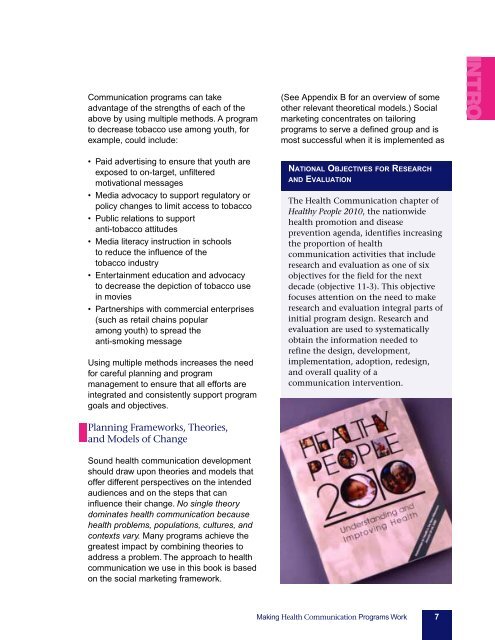pink-book
pink-book
pink-book
You also want an ePaper? Increase the reach of your titles
YUMPU automatically turns print PDFs into web optimized ePapers that Google loves.
Communication programs can take<br />
advantage of the strengths of each of the<br />
above by using multiple methods. A program<br />
to decrease tobacco use among youth, for<br />
example, could include:<br />
(See Appendix B for an overview of some<br />
other relevant theoretical models.) Social<br />
marketing concentrates on tailoring<br />
programs to serve a defined group and is<br />
most successful when it is implemented as<br />
INTRO<br />
• Paid advertising to ensure that youth are<br />
exposed to on-target, unfiltered<br />
motivational messages<br />
• Media advocacy to support regulatory or<br />
policy changes to limit access to tobacco<br />
• Public relations to support<br />
anti-tobacco attitudes<br />
• Media literacy instruction in schools<br />
to reduce the influence of the<br />
tobacco industry<br />
• Entertainment education and advocacy<br />
to decrease the depiction of tobacco use<br />
in movies<br />
• Partnerships with commercial enterprises<br />
(such as retail chains popular<br />
among youth) to spread the<br />
anti-smoking message<br />
Using multiple methods increases the need<br />
for careful planning and program<br />
management to ensure that all efforts are<br />
integrated and consistently support program<br />
goals and objectives.<br />
Planning Frameworks, Theories,<br />
and Models of Change<br />
Sound health communication development<br />
should draw upon theories and models that<br />
offer different perspectives on the intended<br />
audiences and on the steps that can<br />
influence their change. No single theory<br />
dominates health communication because<br />
health problems, populations, cultures, and<br />
contexts vary. Many programs achieve the<br />
greatest impact by combining theories to<br />
address a problem. The approach to health<br />
communication we use in this <strong>book</strong> is based<br />
on the social marketing framework.<br />
NATIONAL OBJECTIVES FOR RESEARCH<br />
AND EVALUATION<br />
The Health Communication chapter of<br />
Healthy People 2010, the nationwide<br />
health promotion and disease<br />
prevention agenda, identifies increasing<br />
the proportion of health<br />
communication activities that include<br />
research and evaluation as one of six<br />
objectives for the field for the next<br />
decade (objective 11-3). This objective<br />
focuses attention on the need to make<br />
research and evaluation integral parts of<br />
initial program design. Research and<br />
evaluation are used to systematically<br />
obtain the information needed to<br />
refine the design, development,<br />
implementation, adoption, redesign,<br />
and overall quality of a<br />
communication intervention.<br />
Making Health Communication Programs Work 7


